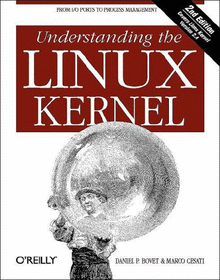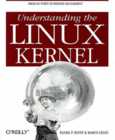Understanding the Linux Kernel

Book Details:
| Publisher: | O'Reilly Media |
| Series: | OReilly |
| Author: | Marco Cesati |
| Edition: | 1 |
| ISBN-10: | 0596002130 |
| ISBN-13: | 9780596002138 |
| Pages: | 816 |
| Published: | Dec 01 2002 |
| Posted: | Nov 19 2014 |
| Language: | English |
| Book format: | CHM |
| Book size: | 1.95 MB |
Book Description:
To thoroughly understand what makes Linux tick and why it's so efficient, you need to delve deep into the heart of the operating system--into the Linux kernel itself. The kernel is Linux--in the case of the Linux operating system, it's the only bit of software to which the term "Linux" applies. The kernel handles all the requests or completed I/O operations and determines which programs will share its processing time, and in what order. Responsible for the sophisticated memory management of the whole system, the Linux kernel is the force behind the legendary Linux efficiency.The new edition of Understanding the Linux Kernel takes you on a guided tour through the most significant data structures, many algorithms, and programming tricks used in the kernel. Probing beyond the superficial features, the authors offer valuable insights to people who want to know how things really work inside their machine. Relevant segments of code are dissected and discussed line by line. The book covers more than just the functioning of the code, it explains the theoretical underpinnings for why Linux does things the way it does.The new edition of the book has been updated to cover version 2.4 of the kernel, which is quite different from version 2.2: the virtual memory system is entirely new, support for multiprocessor systems is improved, and whole new classes of hardware devices have been added. The authors explore each new feature in detail. Other topics in the book include:Memory management including file buffering, process swapping, and Direct memory Access (DMA) The Virtual Filesystem and the Second Extended Filesystem Process creation and scheduling Signals, interrupts, and the essential interfaces to device drivers Timing Synchronization in the kernel Interprocess Communication (IPC) Program executionUnderstanding the Linux Kernel, Second Edition will acquaint you with all the inner workings of Linux, but is more than just an academic exercise. You'll learn what conditions bring out Linux's best performance, and you'll see how it meets the challenge of providing good system response during process scheduling, file access, and memory management in a wide variety of environments. If knowledge is power, then this book will help you make the most of your Linux system.
Download Link:
Related Books:
Understanding the Linux Kernel
3rd Edition
In order to thoroughly understand what makes Linux tick and why it works so well on a wide variety of systems, you need to delve deep into the heart of the kernel. The kernel handles all interactions between the CPU and the external world, and determines which programs will share processor time, in what order. It manages limited memory so well that hundreds of processes can share the system efficiently, and expertly organizes data transfers so that the CPU isn't kept waiting any longer than necessary for the relatively slow disks. The third edition of Understanding the Linux Kernel takes you on a guided tour of the most significant data structures, alg...
Understanding the LINUX Kernel
From I/O Ports to Process Management
Why is Linux so efficient? Is it the right operating system for a particular application? What can be learned from looking at the kernel source code? These are the kinds of questions that Understanding the Linux Kernel takes in stride in this guided tour of the code that forms the core of all Linux operating systems.Linux is presented too often as a casual hacker experiment. It has increasingly become not only a mission-critical part of many organizations, but a sophisticated display of programming skill. It incorporates many advanced operating system concepts and has proven itself extremely robust and efficient for a wide range of uses.Understanding the Linux Kernel helps readers understand how Linux performs best and how it meets the challenge of d...
Understanding the Linux Virtual Memory Manager
A programmer wanting to understand the workings of the Linux VM today literally has no choice but to study the kernel source code, line-by-line - an excruciatingly difficult and time-consuming task. This book dedicates itself to explaining, in detail, how the memory manager is implemented in Linux, thereby cutting down the time needed to understand it from many months to mere weeks. The Linux VM is the single most important component of the Linux kernel. The behavior of the VM affects all other kernel subsystems, and has a dramatic impact on overall system performance. This book is unique in that not only does it describe the Linux VM itself in unprecedented detail, it also includes the theoretical foundations for it which is of interest to both deve...
2007 - 2021 © eBooks-IT.org



